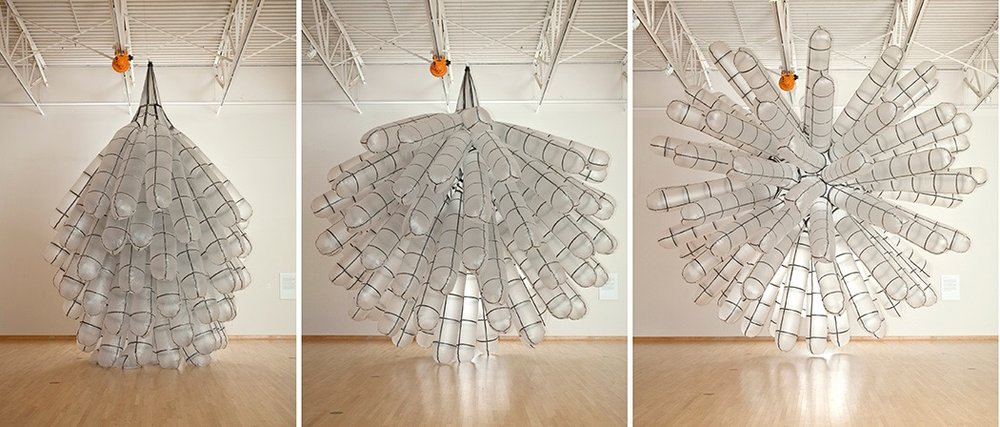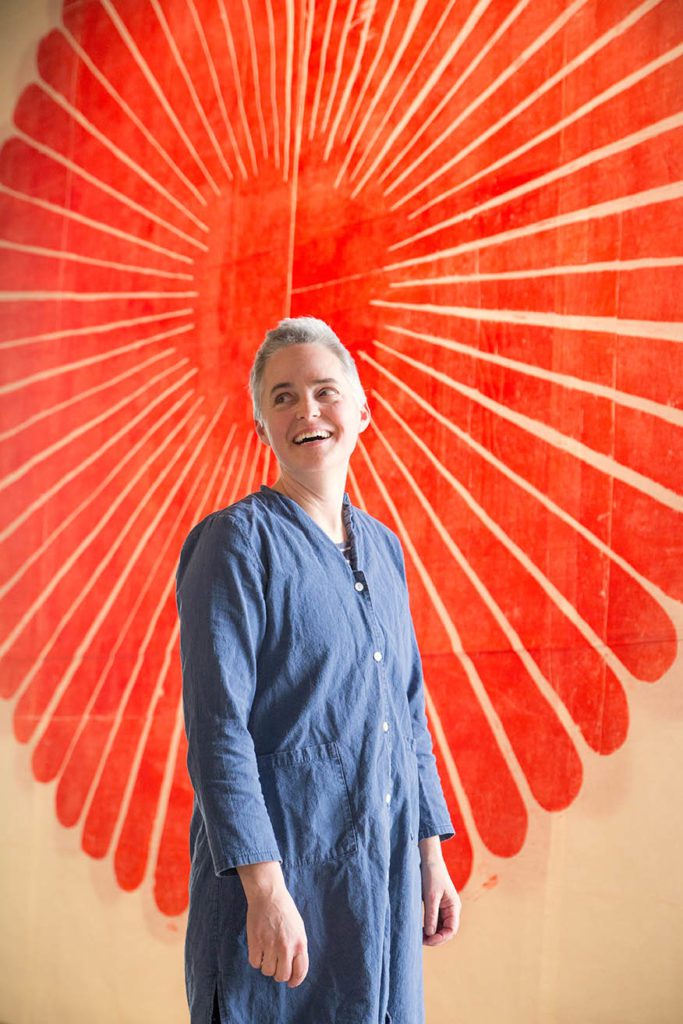Interview with Anna Hepler

 When I first met Anna Hepler years ago, she was working in a studio down the street from my house in Portland, Maine. The work I remember from that first day was tiny, simple drawings. Each one looked almost like an unexpected organism that showed up on a slide under a microscope. Years later, I felt transported by her installation in the Great Hall at the Portland Museum of Art. Her gigantic, floating orb seemed to have dropped into the museum from another world. Thank you to Anna, for sharing your history and process with us. You’re an inspiration.
When I first met Anna Hepler years ago, she was working in a studio down the street from my house in Portland, Maine. The work I remember from that first day was tiny, simple drawings. Each one looked almost like an unexpected organism that showed up on a slide under a microscope. Years later, I felt transported by her installation in the Great Hall at the Portland Museum of Art. Her gigantic, floating orb seemed to have dropped into the museum from another world. Thank you to Anna, for sharing your history and process with us. You’re an inspiration.
Let’s go all the way back to your first experiences as an artist. Did you grow up in a creative family? Where/what was your childhood like and how do you think it lead you toward the artful life you have?
My mother loves making things from scratch and she built a life for all of us that was rich with homemade things— clothing, pottery, candles, gardens, knitting, spinning— everything. Her vision as a designer could be called “Shaker-modern” where bare wood, and a pragmatic minimalism was what we knew. Her pottery took influences from the simplicity of Asian ceramics falling somewhere between Japanese and Danish sensibilities. I don’t mean to suggest that she was rigid. Her spaces are friendly and welcoming, but spare and visually clear. My aesthetic world was shaped by her decisiveness, discernment, and clarity for how the physical world could look and behave. And with her exploration of craft, I followed. I was interested to learn how to make things, and I wanted to try everything she tried. By the time I finished elementary school I was confident as a maker. Whether my interest could be called art is certainly another question, and I continue to take as much pleasure from building things for the functional realm, as tackling conceptual ideas in the studio.
 The multitude of mediums and scales you work in has always impressed me. Do you tend to work in a variety of scales at once or do you focus on one thing at a time?
The multitude of mediums and scales you work in has always impressed me. Do you tend to work in a variety of scales at once or do you focus on one thing at a time?
Scale has always been an interesting question in my work. The pendulum swings widely and not always rationally. Exhibition and museum spaces are quite large these days, so in order to occupy that architecture without feeling dwarfed by it, one responds by meeting its scale. The work I make for exhibitions and commissions is built to respond to the spaces where the work will be shown, and therefore tends toward the grandiose. In my studio where I bat around ideas in private and explore new avenues, the work is nearly always small, hand held, and intimate. I enjoy the opposite ends of this spectrum and learn from both.In the realm of materials I form few allegiances, and love the problem of struggling with a new process. I have always wondered if I might communicate more clearly through a material that I have not yet tested, so when the opportunity arises, I take it. Recently, I have a bit of a ceramic fever, and am learning how to throw, and build simple forms in that material. It feels fresh being an amateur and the results of exploring a new material often produce wonderfully awkward results. That said, I also enjoy repeating many processes over time. When I have the urge to draw, I usually make prints, and love woodcuts, and dry points especially. In the studio, when the work is at its best, I often am working between materials and between 2D and 3D. The back-and-forth is stimulating, and encourages connections and new ideas where they might not naturally occur. The struggle is choosing what to do when I walk through the door.How do you organize your inspirations?I keep a library of inspirations, either in binders from cutting images out of magazines, or as monographs of favorite artists. My binders are the most gratifying, and contain more of a smorgasbord of influences and ideas. I also keep a sketch book, less for drawing, and more for jotting down possible ideas as they come to me.

 Are there people, places or things that have been highly influential in your life and work? Would you mind sharing?
Are there people, places or things that have been highly influential in your life and work? Would you mind sharing?
Oh yes… there are so many! My first artist role model was Claire Van Vliet, a book artist located in Northern Vermont. I lived and worked with Claire on three occasions as an intern starting when I was 19 years old. With her I published two limited edition books and learned many skills related to production. The experiences I had with Claire formed the foundation upon which I was able to visualize a future, in a professional sense, as a visual artist.Ten years later when I was 29, I was selected as a Henry Luce Foundation scholar and spent one year living and working in Seoul South Korea. This experience was life changing both for the struggle of living in a culture that functioned in a non-intuitive way to my western sensibilities, and for the gifts that came from giving-over to the unknown. My friendships with Lee Jin-Kyung, and Noh Seokmee, both artists, have lasted since then, and I have returned to Korea several times. Aesthetically, it was in Korea that my formative sensibility— rooted in wood, ceramic, and natural fibers— was complicated by finding beauty in neon colors, plastic, and a new found appreciation for impermanence in the hand made world.
You’ve lived in some very interesting places. How have those places informed your work?
Every exposure to discomfort and unfamiliarity feels like a calisthenic for my brain. It is hard to point at specific influences, but I gain every time from being in a new environment. The struggle now is to stay put and grow deeper roots.If you could choose a new place to live and work for a year, where would you go and what would you do?I have a romance about northern places, like Newfoundland. I would love to travel there and live for a while, drink tea in a storm, that kind of thing.
 Sometimes your work looks very primitive, with geological shapes and textures. Other times it feels so futuristic, as if the object is so sophisticated all of the unnecessary components have evolved away. Do you relate more to one idea than the other?
Sometimes your work looks very primitive, with geological shapes and textures. Other times it feels so futuristic, as if the object is so sophisticated all of the unnecessary components have evolved away. Do you relate more to one idea than the other?
I love this question and it points to a fragile aspect of my work, one that is constantly shifting. At what point is a form reduced to nothing, and at what point is a reduced form hyper articulate? It is hard to know. I strive for the origins of forms that interest me, as if there might be a clear message there. But one runs the risk of taking away too much and leaving nothing. There is something about restraint, and a kind of containment that feels powerful and frightening to me. I want my sculptural forms to show simplicity and struggle at the same time. I don’t think my work is pointing to the past or the future, but a kind of basic psychological state containing contradictions… not conflict necessarily, but competing elements that are at loggerheads with each other.
Dedicating yourself to art full time takes a fair amount of confidence. Do you have any advice for someone that may have a dream of being a full time artist, but doesn’t have the confidence to commit to it fully?
I am terrible at giving advice. We all come into our lives so differently.
You’ve been living way Down East for three years. Can you describe the culture there and how it has influenced your life and work? Do you have any images of the area to help people envision the place?
I think it’s magical down there. I love living Down East. It is gritty and hard, but elemental, and exciting for those reasons. Here is a culture where people wear many hats by necessity, and where self reliance is the dominant sensibility. People are makers and producers more than consumers, generating their own entertainment and solving problems on their own. It is a stubborn and conservative place in many ways, but also rich in the currency of human relationships. You might say it is old fashioned.